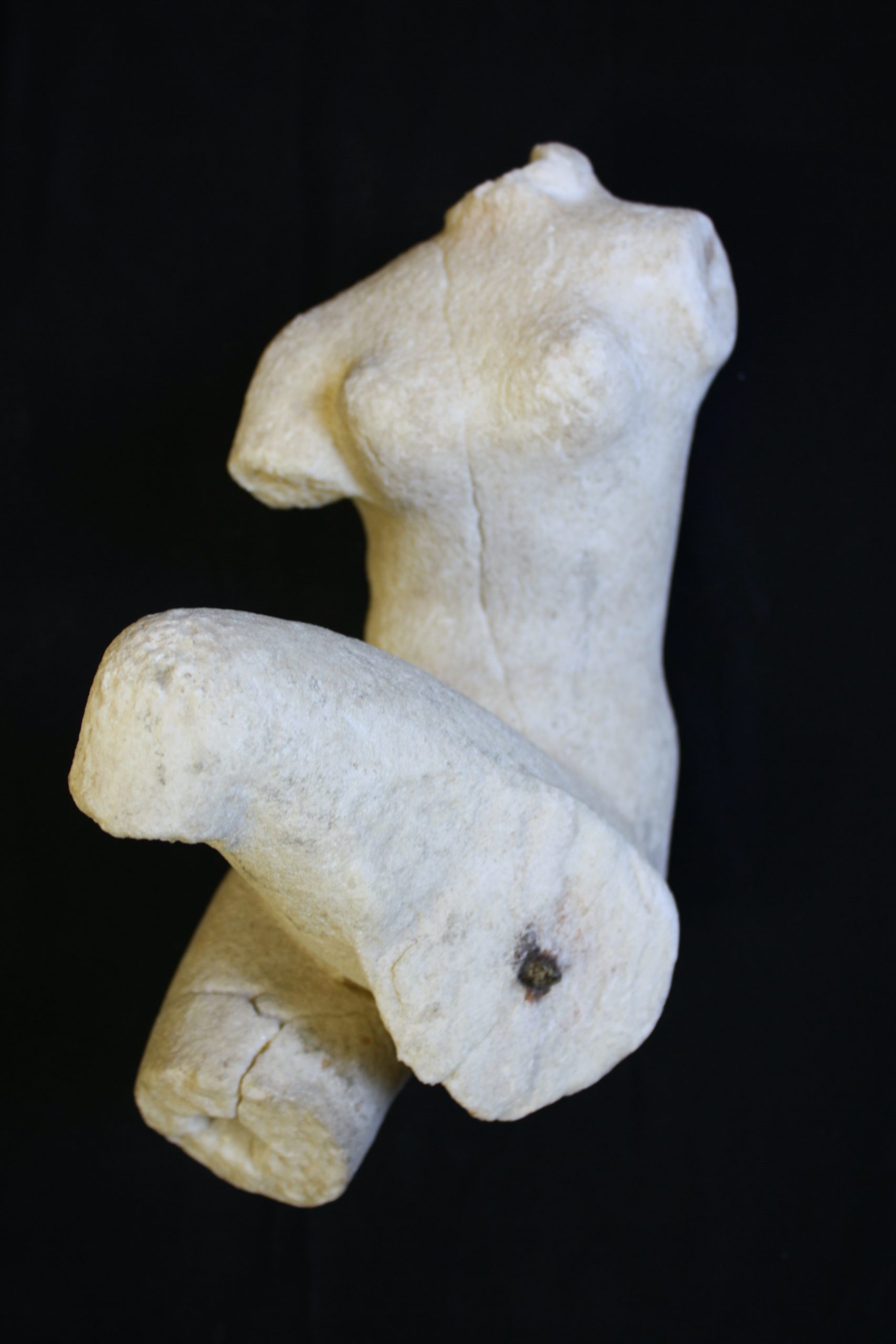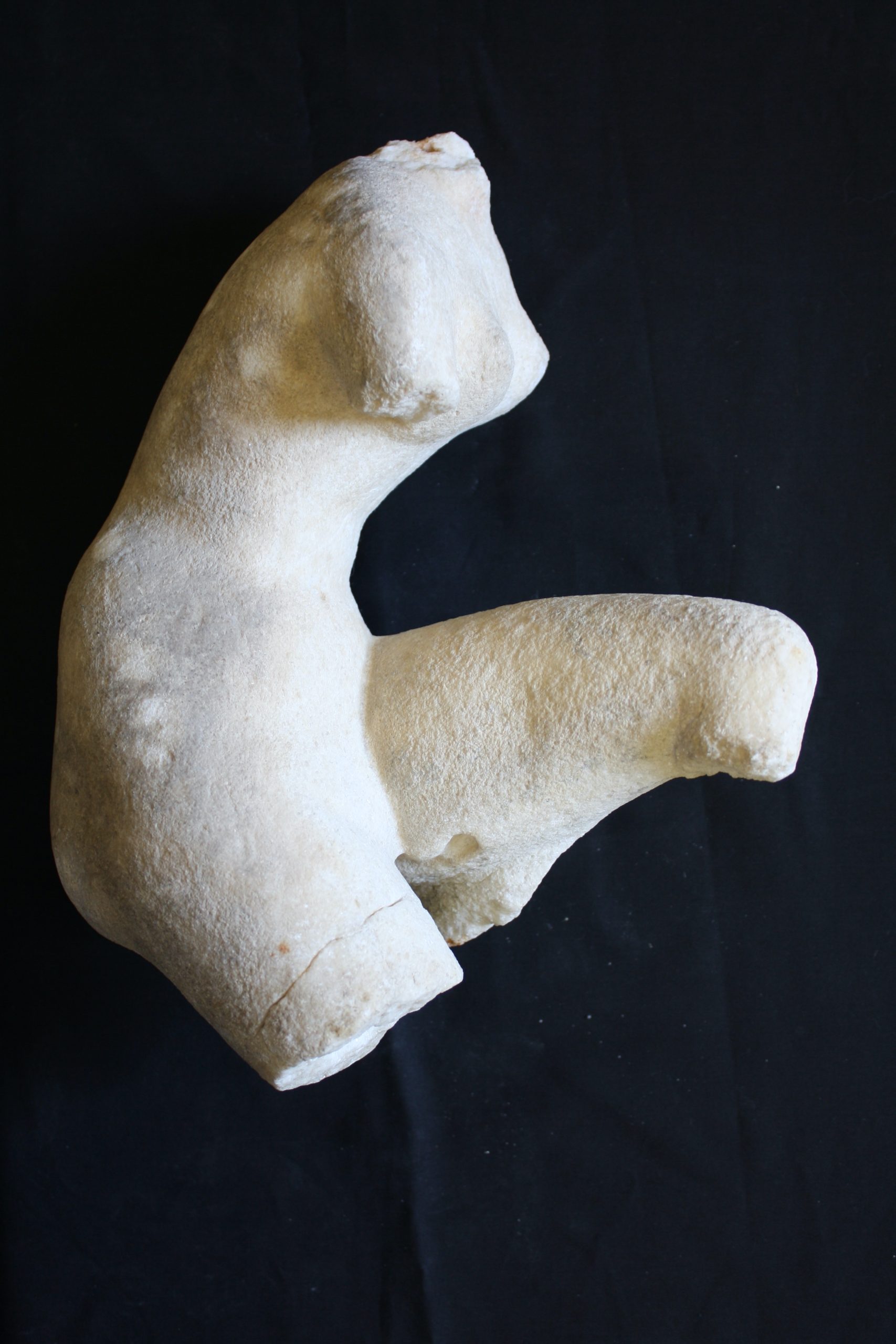Title
Aphrodite untying her sandal
Content
I.D. no: 48912
Dimensions: Max. H. 0.31; Max. W. 15 cm.
Material: Fine-grain white marble
Provenance: From New Street, Rabat[1]
Current location: National Museum of Archaeology, Reserve Collection
Condition: The statuette misses its head, both arms, the right leg from mid-thigh down and the left leg from just under the knee. Holes for dowels appear on the irregular surface of the break on the neck and on the smooth surface of the missing left arm. A thick metallic dowel is still in place on the centre of a large break on the lump of marble projecting from the outer side of the left thigh, suggesting an original attachment (probably a support). A circular hole was drilled in modern times on the surface of the break on the left thigh, surely intended for the insertion of a metallic support. Small chips affect the breasts, the thighs and the buttocks while a deeply scratched line rises from the behind the right waist, up the back and over the right shoulder to descend down across the chest to the left hip. The whole surface of the marble is roughened by corrosion.[2] Inexplicable are two small and adjoining shallow depressions on the inner side of the upper end of the left thigh.
Description: The surviving torso represents the naked body of a female figure standing on its right leg and raising the bent left one while the upper torso is bent forward with the right arm stretching down to reach the left foot, thus creating a remarkable twist of the body. From better surviving replicas, the left arm appears to have been stretched out to provide a counterbalance or, more probably, to seek support on another (now missing) object. The modelling of the naked body reveals a preference for ample forms from the waist down, in contrast with the leaner bust and relatively small adolescent breasts, typical of late-Hellenistic proportions of the female body.
Discussion: The torso undoubtedly belongs to a nude Aphrodite leaning forward to untie with her right hand the sandal from her left foot while raising high the left arm for balance, a motif with a wide diffusion in the Hellenistic age, especially in Asia Minor, the Aegean islands and in Alexandria.[3] Many of these, especially the statuettes in bronze and terracotta are free-standing, without a side support,[4] whereas the Rabat statuette clearly had a support attached to her left thigh, at exactly the same position as the statuette from Smyrne in the Badische Landesmuseum in Karlsruhe, whose left foot is also resting on a dolphin.[5] Another, in many respects perfect, parallel is the statue in marble of roughly the same size from the ‘Villa of Poppea’ in Oplontis whose left thigh is attached to, and supported by a tree trunk fronted by a statuette of a draped female figure, probably a priestess, while a tiny winged Eros stands under, and supports the left foot.[6] The most famous of the lot, however, is the painted marble statuette leaning onto a figure of Priapus, the ‘Bikini Aphrodite’ in the National Museum of Naples.[7]
Even though it lacks finesse and refinement in detail, the statuette shows a notable sensitivity for the general concept of the nude female body. It must have belonged to a reasonably artful artisanal work produced in the late Hellenistic age or, more likely, the first century of Roman imperial age.
Bibliography: (previous publications of item): Zammit in M.A.R. 1904-05: 1; Zammit 1919: 24 (‘found in 1906’), 25 (the same number, but ‘found in 1907’). Bonanno 1972: 81-84.
[1] Information from a note in the ‘Ashby Box’ in the archive of the British School at Rome: ‘gritty marble from drainage works at Notabile. H. 0.24. From Strada Nuova Rabat Notabile 1906’.
[2] This was more of a perception resulting from the dirty grey patina that covered almost the whole marble surface when it was photographed in 1971. This unsightly patina was cleaned away in a conservation exercise in the 1990s.
[3] Delivorrias et al. 1984: vol. II,1: 57-59; vol. II, 2: nos 463-80: ‘Die sandalenlösende Aphrodite’. See also Bieber 1955: 99, 104; Adriani (1961: vol. 2: 26, nos 102-05, pls 58-59, figs 179-86) suggests, on the basis of the evidence from choroplastic art that the prototype, probably a life-size statue in bronze, was created between the end of the 3rd and the beginning of the 2nd centuries BC.
[4] Such as the 18 cm high bronze replica from Caesarea Mauretaniae (Cherchell), almost perfectly intact, which reproduces perfectly, not only the posture of our figure but also the internal proportions between the different parts of the body, in particular the slim upper torso in contrast with the fuller lower torso (Landwehr 1993: 23-24, no 6, pls 13-15).
[5] Delivorrias et al. 1984: vol. II,1: 58, no 464; Breuer 2001: 62-63, no. 35 (dated to the second half of the 2nd century BC). The large break and dowel on the left thigh in our statuette also corresponds to the point of attachment with the main support in the Karlsruhe figure, which consists of a draped object fronted by a broken rudder.
[6] De Caro 1976: 219-25. Moorman 2019: Cat. no 1, Figs 16.1-2
[7] Kraus & von Matt 1973: 194, pls 270-71.




